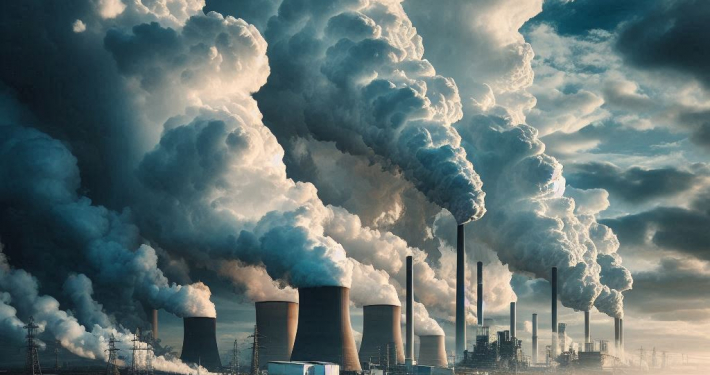Pollution is usually associated with traffic congestion, power stations, or poor air quality warnings—not with the performance of HVAC systems. Yet, across the UK, pollution is silently corroding heat exchangers, shortening the lifespan of equipment, and pushing energy usage upwards.
Blygold explores how specific airborne pollutants—Nitrogen Oxides (NO₂) and Sulphur Dioxides (SO₂)—are accelerating the breakdown of HVAC coils. We’ll also look at how this hidden issue contributes to operational inefficiencies and undermines Net Zero goals. Finally, we highlight a government-backed resource—the National Atmospheric Emissions Inventory (NAEI)—that can help facilities teams identify pollution risks and take preventative action.
Understanding Coil Corrosion in HVAC Systems
HVAC coils are essential to heat exchange and system efficiency. Typically constructed from aluminium fins and copper tubing, they are engineered for maximum thermal performance—but are not inherently corrosion-resistant.
Over time, the accumulation of airborne chemicals on untreated coils leads to:
- Restricted airflow
- Higher power consumption
- Increased service visits
- Early system failure
- Reduced operational lifespan
Because the corrosion process is gradual and often invisible until failure, it tends to fly under the radar until the damage is done.
The Role of NO₂ and SO₂ in Coil Degradation
Nitrogen Oxides and Sulphur Dioxides are two of the most prevalent airborne contaminants in the UK, primarily emitted by transport networks, manufacturing, and energy production.
Once in the atmosphere, these compounds interact with moisture and oxygen, forming nitric and sulphuric acids. These acids return to ground level via precipitation or as dry particulate matter—settling on everything, including exposed HVAC units.
Aluminium fins are particularly reactive with these acids, leading to surface etching, pitting, and irreversible structural weakening. The result: impaired heat transfer, lower system efficiency, and a greater risk of breakdowns.
Beyond the Sea Air: Pollution’s Inland Reach
Corrosion has long been linked with coastal environments, where salt-induced reactions are well documented. However, this narrative has overshadowed a growing inland issue—pollution-induced corrosion.
Buildings located in urban, industrial, or high-traffic areas may be just as vulnerable due to their exposure to airborne chemical compounds. But because there’s no visible salt residue, these risks are often overlooked until performance drops or failure occurs.
This false sense of security has resulted in reactive rather than proactive maintenance approaches in many non-coastal facilities.
Making Use of the NAEI: A Valuable but Underused Resource
To help address this challenge, facility managers and engineers can turn to the National Atmospheric Emissions Inventory (NAEI).
The emissions mapping tool, available at https://naei.energysecurity.gov.uk/emissionsapp/, allows users to view pollutant concentrations by UK postcode—offering granular visibility into NO₂ and SO₂ levels.
Here’s how NAEI supports better HVAC asset planning:
- Data-backed decision-making: Assess actual exposure risk rather than assuming environmental conditions.
- Asset-level insight: Pinpoint HVAC systems operating in high-risk areas before issues arise.
- Targeted investment: Direct maintenance budgets to the locations where corrosion protection will deliver the greatest return on investment.
Despite its precision and accessibility, the NAEI is seldom factored into HVAC lifecycle planning. It has the potential to become a cornerstone of strategic FM decision-making as well as consultants creating specifications.
Why Coil Condition Links Directly to Net Zero Goals
HVAC performance is a critical component of a building’s energy profile. In many commercial and public buildings, HVAC systems account for the lion’s share of electricity use—often between 40% and 50%.
Pollution-induced coil corrosion undermines Net Zero targets by driving:
- Excess energy demand
- Increased system strain and CO₂ emissions
- Poor thermal comfort and air quality
Protecting coils from early degradation directly improves system efficiency—thereby lowering Scope 1 and Scope 2 emissions. For businesses with environmental, social and governance (ESG) targets, this is a meaningful area of action that delivers measurable results.
Investing in Protection: Why It Pays Off
Specialist coatings such as Blygold’s PoluAl can shield HVAC coils from chemical corrosion without compromising performance. These advanced protective layers resist acid attack while maintaining high levels of thermal conductivity.
When applied by qualified professionals—either pre-installation or on existing units—the benefits include:
- Significantly extended coil service life
- Enhanced energy efficiency (by up to 12%)
- Reduced maintenance and repair needs
- Improved system reliability
- Better alignment with sustainability goals
Most systems show a strong financial return within 1–2 years, especially when factoring in avoided emergency repairs or premature replacement.
Practical Use Cases: Pollution Data Driving Smarter HVAC Planning
Let’s consider two practical examples where NAEI data supports maintenance strategy:
- Retail warehouse near a major dual carriageway: Pollution mapping reveals high NOₓ concentrations throughout the year. Coil protection is applied to roof-mounted condensers, significantly reducing the corrosion rate and lowering electricity usage.
- City-centre university campus: A combination of nearby rail infrastructure and urban density results in high SO₂ readings. Targeted protective treatments are applied to indoor air handling units and rooftop chillers, ensuring stable air quality and thermal output in lecture theatres and labs.
These cases show that pollution protection isn’t speculative—it’s a smart, evidence-based intervention with operational and environmental advantages.
Recommendations for Facility Managers and HVAC Stakeholders
If you manage HVAC systems in any of the following locations, it’s time to treat pollution as a core consideration—not an afterthought:
- Near motorways, A-roads or rail lines
- Close to factories, processing plants or foundries
- Within airport zones or near flight paths
- Urban rooftops or inner-city locations
- Multi-storey car parks or transport hubs
Start by using the NAEI to evaluate pollution levels at your asset locations. If NOₓ or SO₂ is high, coil protection should be a top priority in your maintenance plan.
From there, consult with a corrosion protection specialist such as Blygold to assess options for implementation.
Conclusion: Recognising Pollution as a Maintenance Risk—and an Opportunity
Coil corrosion from airborne pollutants represents a hidden but widespread risk to HVAC infrastructure in the UK. However, this challenge also presents a clear opportunity for energy savings, carbon reduction, and smarter facilities management.
By integrating pollution mapping tools like the NAEI into asset planning, FM professionals can unlock a new level of operational insight—proactively managing equipment life cycles and contributing to long-term sustainability goals.
At Blygold, we believe in turning invisible risks into visible results. Coil protection, powered by pollution data, is one of the most effective and accessible ways to do just that.
With thanks to: © Crown 2025 copyright Defra & DESNZ via naei.energysecurity.gov.uk licenced under the Open Government Licence (OGL).



